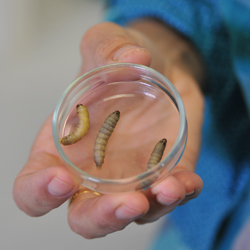
Inequality is the defining social, political and economic phenomenon of our time. Just 1% of the world’s population now holds over 35% of all private wealth, more than the bottom 95% combined. Bad as this may seem, trends suggest that the situation will only get worse. Addressing it will involve multiple strategies working together, but one which is less well understood is how simple, affordable solutions to people’s problems can make a genuine difference from the bottom up. 
One way of measuring inequality is known as the Gini coefficient. It gives us a useful and straightforward number between zero and one, where zero represents perfect equality where everyone has the same income, and one expresses the maximum of inequality. In the countries which make up the Organisation for Economic Cooperation and Development (OECD) the Gini was at 0.28 in the mid-1980s, but increased by 10% to 0.31 by the late 2000s.
Inequality is a global problem. In the form of absolute poverty, it exists across countries. About 4 billion people – more than half the world’s population – live on less than US$9 a day. But inequality is also a problem within countries. By the late 2000s, income inequality measured by Gini had risen in 17 out of the 22 OECD countries – in Finland, Germany, Israel, New Zealand, Sweden and the US, it increased by more than 4%.

Making demands
Inequality is also a problem that exists on both the demand and supply sides of the economy. On the demand side: large numbers of people are excluded from the fruits of the economic process as they lack access to basic healthcare, education, nutritious food, and clean energy. This is largely an emerging world problem, but it is also increasingly a problem in the developed world.
On the supply side, large numbers of people are excluded from the economic process because they are shut out of employment in high-value-adding industries which rely heavily on skills and technology. This is largely a problem in the developed world where globalisation and tech have hollowed out manufacturing, but it is a problem in some developing countries too.
My work over the last decade leads me to believe that an important part of the battle against inequality lies in what could be termed frugal innovation. Simply put, it is about applying human ingenuity to create faster, better and cheaper solutions for more people in core areas such as financial services, health, education and energy. We can call it “frugal” because this is not about massive state-level or corporate investment, but it is about developing and delivering affordable technologies and ideas to meet basic needs at scale. This has the potential to address both supply and demand side aspects of inequality.
On the demand side, developing these frugal solutions across sectors promises to include large numbers of people currently without access to affordable financial services, education, and healthcare. Indeed, such a frugal revolution is already taking place in emerging markets in South Asia, Africa and Latin America. In India, such solutions in healthcare are bringing free or highly affordable services to large numbers of people in areas as diverse as cataract and heart surgery and prosthetics. Across the country, Devi Shetty has applied medical and management principles to reduce the cost of heart surgery to US$1,200 while maintaining global quality standards. He wants to get the price down to US$800.

In Africa, an earlier telecoms revolution is now driving a second generation of frugal solutions in key sectors such as financial services. M-Pesa, an SMS-enabled service that enables unbanked people to send and receive money though their mobile phones, has empowered over 25m Kenyans (many of whom have small businesses) to improve productivity and gain access to revenue-generating opportunities. Such mobile based payments are in turn driving affordable market solutions in areas such as solar lighting for those living beyond the reach of the electricity grid.
Similar frugal solutions in clean cookstoves, medical devices, transport, pharmaceuticals, sanitation, and consumer electronics are positioned to drive growth in Asia and Africa over the next few decades, helping to raise millions out of absolute poverty in the process.
Job makers
On the supply side, frugal innovation offers the possibility of generating more high value adding employment for more people, particularly in Western economies. Big corporations are increasingly lean and no longer hire the large numbers of people they did in the past. And so entrepreneurship is more than ever a key driver of growth, both in terms of output as well as in generating employment. Young people entering the workforce can no longer expect to be job takers; increasingly, they are expected to be job makers.
Luckily, they are now more empowered to do so: small teams of people can set up new companies and achieve scale in ways that weren’t possible before.

Technologies such as cheap computers, sensors, smartphones, and 3D printers are enabling such teams to invent and prototype in ways that were only available to large corporations or government labs in the past. This in turn has given rise to the maker movement where budding inventors can tinker in Make Spaces and Fab Labs with other like-minded people and develop solutions to problems they face in their communities. Ideas that have come out of Tech Shops and Make Spaces include the Embrace Baby Warmer and Simprints, a biometric device to manage medical records in the field in developing countries.
If these “makers” wish to commercialise their solutions, they can crowdfund the capital needed, outsource the manufacturing, list their products on amazon.com to help with distribution and use social media to spread the word. Indeed, such “maker spaces” could well morph into the high tech, local, sustainable factories of the future, delivering high value adding, creative manufacturing opportunities to cities where 20th-century polluting manufacturing has been systematically weakened over the last few decades, and where lost jobs in those sectors have sharpened inequality.
While most politicians and policy makers fulminate and flounder in their attempt to deal with rising inequality worldwide, a quiet frugal revolution is already addressing the problem right before their eyes. The state need not be a bystander. Now is the time for governments to sit up, take notice and spur this revolution on. Doing so could help save their societies and economies before it is too late.
This article has been co-published with the World Economic Forum.
Jaideep Prabhu, Director, Centre for India & Global Business, Cambridge Judge Business School
This article was originally published on The Conversation. Read the original article.
With inequalities set to get worse, it’s time to take radical action, says Jaideep Prabhu, Director of Centre for India & Global Business, Cambridge Judge Business School, writing for The Conversation. Could the answer lie in the ‘frugal revolution’ that is already under way?

The text in this work is licensed under a Creative Commons Attribution 4.0 International License. For image use please see separate credits above.

























